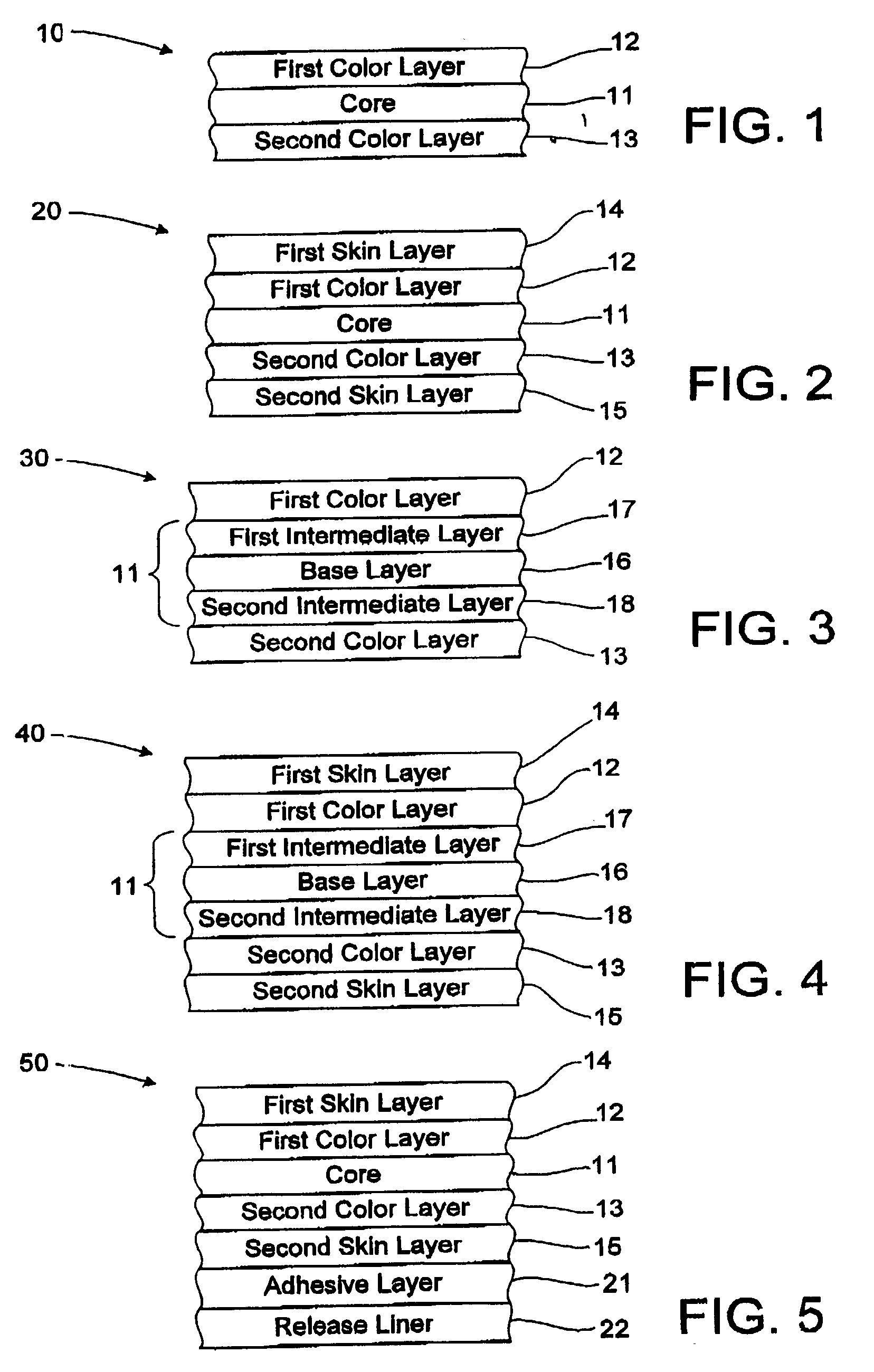Coextruded Multilayer Colored Films
a multi-layer, colored film technology, applied in the direction of transportation and packaging, synthetic resin layered products, other domestic articles, etc., can solve the problems of troublesome problems, degrade the functionality of adhesive composites, and films that are not entirely acceptable, so as to reduce the thickness of color layers and reduce costs
- Summary
- Abstract
- Description
- Claims
- Application Information
AI Technical Summary
Benefits of technology
Problems solved by technology
Method used
Image
Examples
example 1
Core (0.50 mil)
[0046] 2% Ampacet Black 190671A
[0047] 25% Equistar EVA 242F
[0048] 72% Huntsman MDPE PE-1080
[0049] 1% Ampacet Process Aid Conc. 10919
First Color Layer (0.6 mil)
[0050] 20% Ampacet White 110868
[0051] 25% AT Plastics EVA 1821
[0052] 54% Huntsman MDPE PE-1080
[0053] 1% Ampacet Process Aid Conc. 10919
Second Color Layer (0.6 mil)
[0054] 2% Ampacet Black 190671A
[0055] 25% Equistar EVA 242F
[0056] 72% Huntsman MDPE PE-1080
[0057] 1% Ampacet Process Aid Conc. 10919
example 2
Core (0.50 mil)
[0058] 2% Ampacet Black 190671A
[0059] 25% Equistar EVA 242F
[0060] 72% Huntsman MDPE PE-1080
[0061] 1% Ampacet Process Aid Conc. 10919
First Color Layer (0.6 mil)
[0062] 20% Ampacet White 110868
[0063] 25% AT Plastics EVA 1821
[0064] 54% Huntsman MDPE PE-1080
[0065] 1% Ampacet Process Aid Conc. 10919
Second Color Layer (0.6 mil)
[0066] 2% Ampacet Black 190671A
[0067] 25% Equistar EVA 242F
[0068] 72% Huntsman MDPE PE-1080
[0069] 1% Ampacet Process Aid Conc. 10919
First Skin Layer (0.25 mil-Transparent)
[0070] 94% Surlyn 9120
[0071] 5% Ampacet UV Concentrate 10561
[0072] 1% Ampacet Process Aid Conc. 10919
Second Skin Layer (0.25 mil-transparent)
[0073] 63% Huntsman MDPE PE-1080
[0074] 35% Equistar EVA 242F
[0075] 1% Ampacet UV Conc. 10561
[0076] 1% Ampacet Process Aid Conc. 10919
example 3
Core
[0077] Base Layer (0.5 mil) [0078] 72% Huntsman MDPE PE-1080 [0079] 25% Equistar EVA 242F [0080] 2% Ampacet Black 190671A [0081] 1% Ampacet Process Aid Conc. 10919
[0082] First Intermediate Layer (0.6 mil) [0083] 54% Huntsman MDPE PE-1080 [0084] 25% AT Plastics EVA 1821 [0085] 20% Ampacet white 110868 [0086] 1% Ampacet Process Aid Conc. 10919
[0087] Second Intermediate Layer (0.6 mil) [0088] 54% Huntsman MDPE PE-1080 [0089] 25% AT Plastics EVA 1821 [0090] 20% Ampacet white 110868 [0091] 1% Ampacet Process Aid Conc. 10919
First Color Layer (0.65 mil)
[0092] 45% Ampacet Cardinal Red 150623
[0093] 28% Huntsman MDPE PE-1080
[0094] 25% Equistar EVA 242F
[0095] 1% Ampacet UV Conc. 10561
[0096] 1% Ampacet Process Aid Conc. 10919
Second Color Layer (0.65 mil)
[0097] 45% Ampacet Cardinal Red 150623
[0098] 28% Huntsman MDPE PE-1080
[0099] 25% Equistar EVA 242F
[0100] 1% Ampacet UV Conc. 10561
[0101] 1% Ampacet Process Aid Conc. 10919
PUM
| Property | Measurement | Unit |
|---|---|---|
| Fraction | aaaaa | aaaaa |
| Color | aaaaa | aaaaa |
| Abrasion resistance | aaaaa | aaaaa |
Abstract
Description
Claims
Application Information
 Login to View More
Login to View More - R&D
- Intellectual Property
- Life Sciences
- Materials
- Tech Scout
- Unparalleled Data Quality
- Higher Quality Content
- 60% Fewer Hallucinations
Browse by: Latest US Patents, China's latest patents, Technical Efficacy Thesaurus, Application Domain, Technology Topic, Popular Technical Reports.
© 2025 PatSnap. All rights reserved.Legal|Privacy policy|Modern Slavery Act Transparency Statement|Sitemap|About US| Contact US: help@patsnap.com


